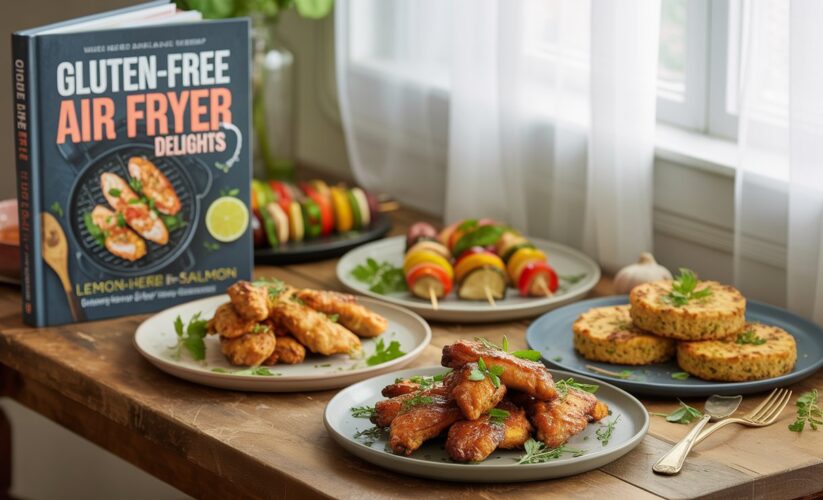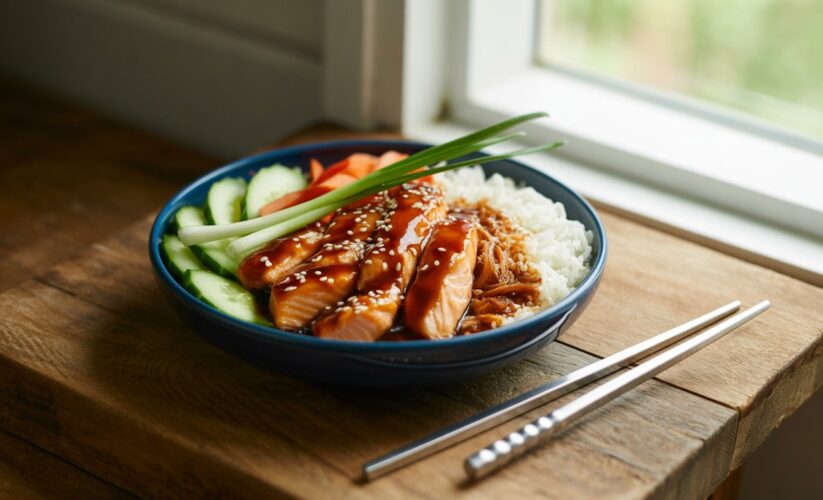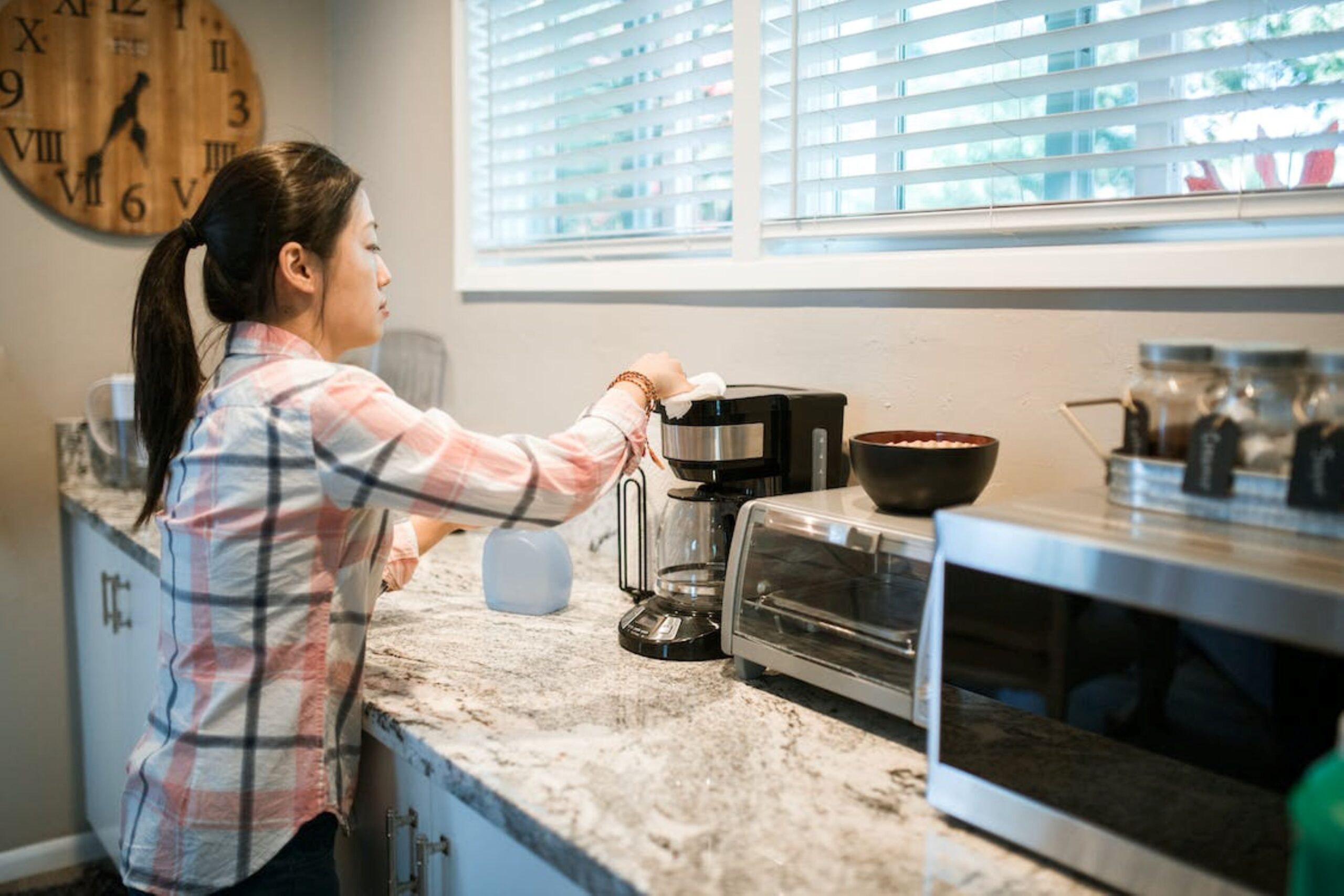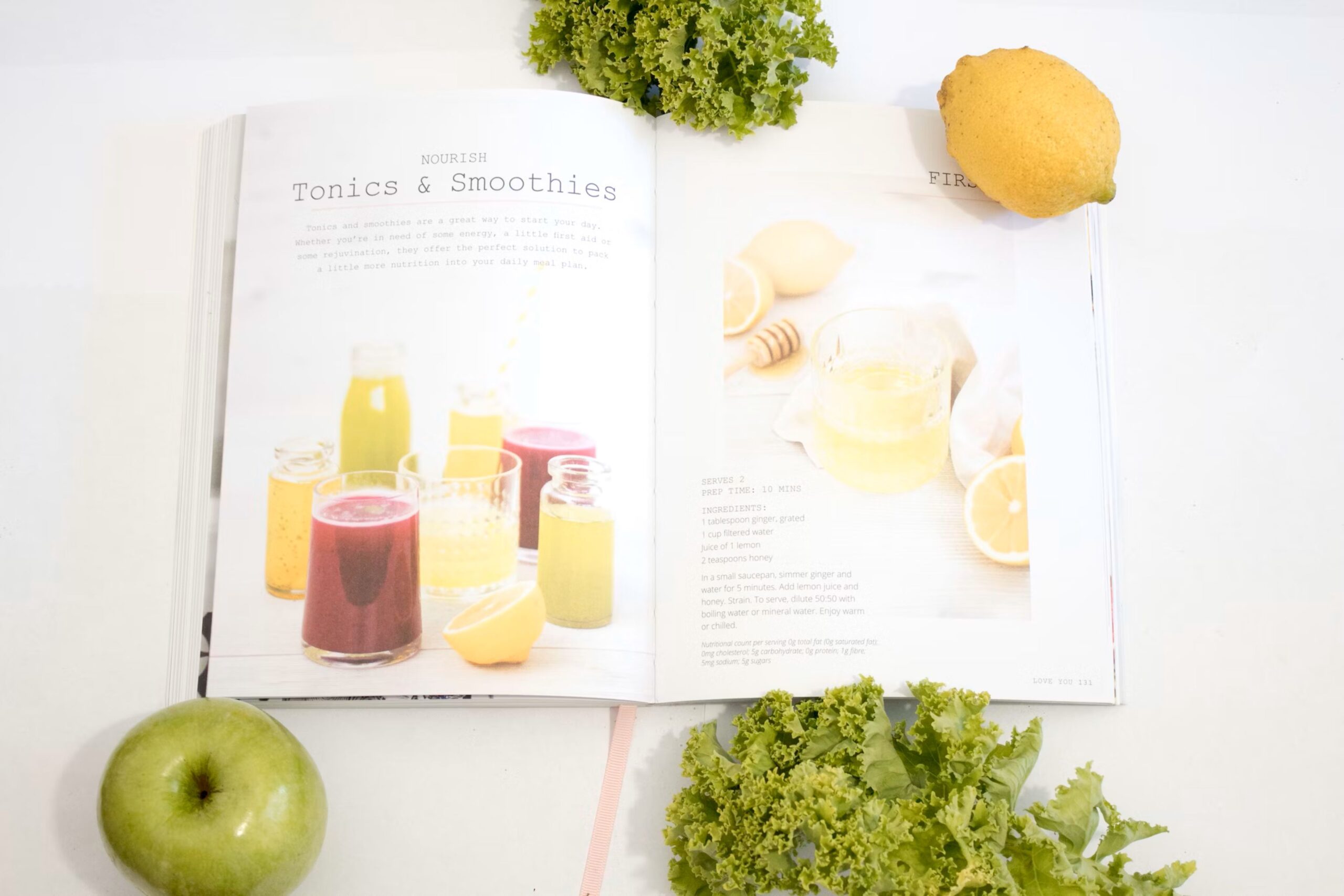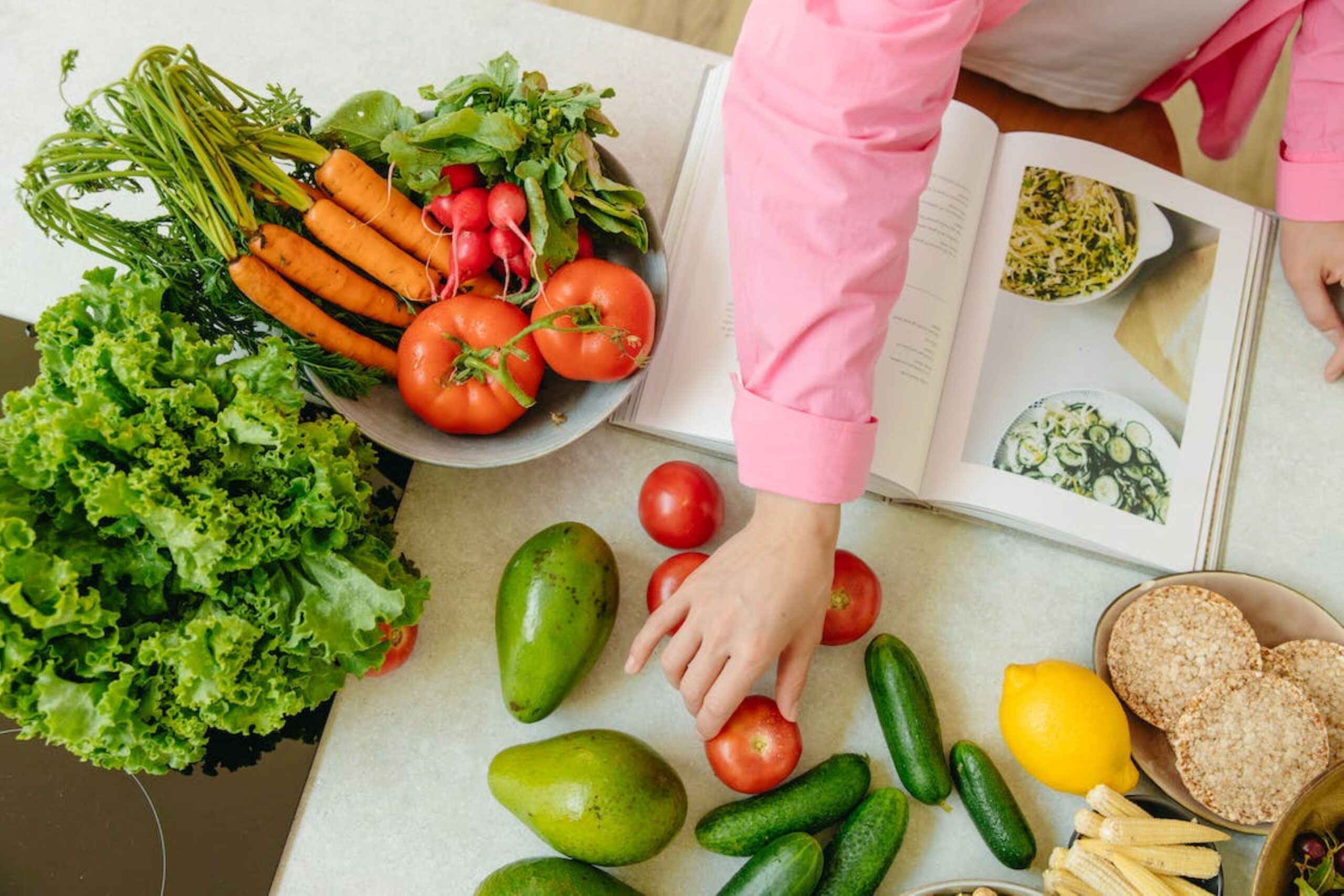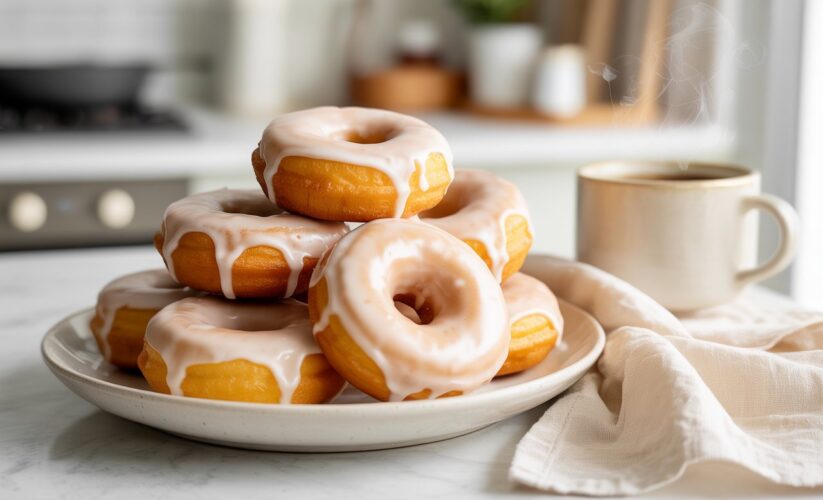
Air Fryer Donuts No Yeast – Quick & Easy Glazed Treats
The aroma of freshly made donuts wafting through the kitchen at 7 AM on a Saturday morning – there’s something magical about that moment when you realize you don’t need to wait hours for yeast to work its slow magic or heat up gallons of oil. The discovery that perfectly fluffy, golden donuts could emerge from an air fryer in just minutes, using simple pantry ingredients, changed everything about weekend mornings and spontaneous dessert cravings.
“The secret to great baking isn’t always complexity – sometimes it’s finding the simplest path to exceptional results. Air fryer donuts prove that innovation often means eliminating unnecessary steps, not adding them.”
– Culinary Innovation Institute
Key Takeaways
- No yeast needed: These donuts use baking powder for instant leavening
- Healthier option: Air frying reduces oil content by up to 80% compared to deep frying
- Quick preparation: Ready in under 30 minutes from start to finish
- Versatile base: Works with countless flavor variations and toppings
- Kitchen-friendly: No special equipment beyond an air fryer required
- The XL air fryer with 2 independent baskets that lets you cook 2 foods, 2 ways, at the same time, eliminating back-to-back cooking like a traditional single-basket air fryer.
- DualZone Technology allows you to choose between the Smart Finish feature, which unlocks cooking 2 foods 2 ways that finish at the same time, and the Match Cook feature, which easily copies settings across zones for full 10-qt. capacity meals.
- IQ Boost optimally distributes power across each basket to cook a 6-lb. whole chicken and side as quickly as possible when Match Cook or Smart Finish is not selected.
- AIR CRISP TECHNOLOGY: 400℉ superheated air surrounds food for hot, crispy results with little to no oil.
- LARGE CAPACITY: The 5-QT nonstick basket and crisper plate fit up to 4 lbs of French fries or 5 lbs of chicken wings.
- 4-in-1 FUNCTIONALITY: Air Fry, Roast, Reheat, and Dehydrate.
- FAMILY-SIZED COOKING SYSTEM: 6-qt and 2.5-qt glassware, storage lids, crisper plates, and modular base for any occasion.
- POWERFUL COOKING SYSTEM: 1800-watt air fryer that can cook a 7.5-lb chicken, feeding up to 10 people.
- VERSATILE CAPACITY: Modular base adjusts to fit 2.5-qt, 4-qt, and 6-qt CleanCrisp Glassware for everyday or family-sized meals.
The Journey to Perfect Yeast-Free Donuts
Discovering the Air Fryer Method
The traditional donut-making process often feels daunting – waiting for yeast to activate, kneading dough, allowing rise time, then dealing with hot oil and potential splattering. The breakthrough came when experimenting with baking powder as the primary leavening agent, transforming donut-making from a day-long project into a quick morning treat.
Air fryer donuts without yeast represent a perfect intersection of convenience and indulgence. The circulating hot air creates that coveted golden exterior while keeping the interior tender and fluffy, all while using minimal oil.
The Science Behind Yeast-Free Success
Understanding why these donuts work without yeast reveals the beauty of chemical leavening. Baking powder contains both an acid and a base that react when moistened and heated, creating carbon dioxide bubbles that lift the dough. This immediate reaction eliminates the waiting time associated with biological leavening (yeast) while producing surprisingly similar results.
The key lies in working quickly once the wet and dry ingredients combine, getting the donuts into the air fryer while those leavening reactions are at their peak.
Essential Ingredients and Equipment
The Basic Formula
The foundation of excellent yeast-free air fryer donuts starts with:
- All-purpose flour (2 cups) – provides structure
- Sugar (1/2 cup) – adds sweetness and helps browning
- Baking powder (2 teaspoons) – the crucial leavening agent
- Salt (1/2 teaspoon) – enhances flavor
- Milk (3/4 cup) – creates tenderness
- Egg (1 large) – binds ingredients and adds richness
- Melted butter (3 tablespoons) – contributes to texture and flavor
- Vanilla extract (1 teaspoon) – rounds out the flavor profile
Equipment Essentials
Success requires minimal specialized equipment:
- Air fryer (any size works, though larger models allow bigger batches)
- Donut pan or silicone donut molds that fit your air fryer
- Standard mixing bowls and measuring tools
- Wire cooling rack
Step-by-Step Creation Process
Preparing the Batter
The mixing technique significantly impacts the final texture. In one bowl, whisk together all dry ingredients, ensuring the baking powder distributes evenly throughout the flour. This prevents pockets of intense leavening that could create uneven rising.
In a separate bowl, combine the wet ingredients, whisking until the mixture appears homogeneous. The butter should be melted but not hot enough to cook the egg upon contact.
The Critical Combination
Pour the wet ingredients into the dry ingredients and fold together gently. Overmixing develops gluten strands, resulting in tough, chewy donuts rather than the desired tender texture. Mix just until no dry flour remains visible – the batter should look slightly lumpy, which is perfect.
Shaping and Air Frying
Lightly grease the donut molds with cooking spray or a thin layer of melted butter. Fill each cavity about 2/3 full – this allows room for rising without overflow. Too little batter creates thin, flat donuts, while too much causes overflow and irregular shapes.
Preheat the air fryer to 350°F (175°C) for 3 minutes. Place the filled donut pan in the air fryer basket, ensuring adequate air circulation around the pan. Cook for 8-10 minutes, checking at 6 minutes for color development. The donuts should spring back when lightly touched and appear golden brown.
Overcoming Common Challenges
Density Issues
Dense, heavy donuts typically result from overmixing or using expired baking powder. Fresh baking powder should fizz vigorously when mixed with hot water. Replace baking powder every 12-18 months for optimal results.
Uneven Cooking
Air fryers can have hot spots that cause uneven browning. Rotate the donut pan halfway through cooking time. If your air fryer runs hot, reduce the temperature to 325°F and extend cooking time by 2-3 minutes.
Sticking Problems
Even with greasing, donuts sometimes stick to molds. Allow donuts to cool for 2-3 minutes before attempting removal. Silicone molds generally release more easily than metal ones.
Texture Disappointments
Dry donuts often indicate overcooking or insufficient liquid ingredients. Monitor closely during the final minutes of cooking. Conversely, gummy centers suggest undercooking – extend time in 1-minute increments until done.
Flavor Variations and Customization
Chocolate Lovers’ Versions
Replace 1/4 cup flour with unsweetened cocoa powder for chocolate donuts. Add an extra tablespoon of sugar to balance the cocoa’s bitterness. Mini chocolate chips folded into the batter create delightful surprises in every bite.
Seasonal Specialties
Fall Spiced Donuts: Add 1 teaspoon cinnamon, 1/4 teaspoon nutmeg, and 1/8 teaspoon allspice to the dry ingredients.
Lemon Glazed: Replace vanilla with lemon extract and add 1 tablespoon lemon zest to the batter.
Orange Cranberry: Fold in 1/3 cup dried cranberries and 1 tablespoon orange zest.
Dietary Modifications
Gluten-Free Option: Substitute cup-for-cup gluten-free flour blend, though texture will be slightly different.
Dairy-Free Version: Replace milk with non-dairy alternatives and use plant-based butter or oil.
Reduced Sugar: Cut sugar by half and add 1/4 teaspoon stevia extract, though browning will be reduced.
Glazing and Topping Techniques
Classic Glazes
Simple Powdered Sugar Glaze: Mix 1 cup powdered sugar with 3-4 tablespoons milk and 1/2 teaspoon vanilla. Adjust consistency with additional milk or powdered sugar.
Chocolate Glaze: Combine 1/2 cup powdered sugar, 2 tablespoons cocoa powder, and 3 tablespoons milk.
Creative Toppings
- Cinnamon Sugar: Roll warm donuts in a mixture of 1/2 cup sugar and 2 teaspoons cinnamon
- Coconut Flakes: Press toasted coconut into glazed surfaces
- Crushed Nuts: Chopped almonds, pecans, or peanuts add texture
- Sprinkles: Apply while glaze is still wet for best adhesion
Storage and Reheating
Fresh air fryer donuts taste best within 24 hours of making. Store in an airtight container at room temperature for up to 3 days. For longer storage, freeze unglazed donuts for up to 3 months.
To refresh day-old donuts, warm them in the air fryer at 300°F for 1-2 minutes. This restores some of the original texture and warmth.
Troubleshooting Guide
Problem: Donuts collapse after removing from air fryer
Solution: The batter may be too thin, or donuts are underbaked. Ensure batter coats the spoon and cook until donuts spring back when touched.
Problem: Bitter aftertaste
Solution: Check baking powder freshness. Old or too much baking powder creates metallic, bitter flavors.
Problem: Pale color despite full cooking time
Solution: Increase temperature by 25°F or brush tops lightly with melted butter before cooking to encourage browning.
Problem: Tough, chewy texture
Solution: Reduce mixing time and ensure ingredients are at room temperature for easier combining.
Beyond Basic Donuts: Advanced Techniques
Filled Donuts
Create filled versions by making slightly thicker donuts, then using a piping bag to inject jam, custard, or cream into the center after cooling. A small slit on the side works better than trying to pierce from the top.
Donut Holes
Use excess batter to create donut holes in mini muffin cups. Reduce cooking time to 5-6 minutes for these smaller treats.
Layered Flavors
Create marbled effects by dividing batter and adding different flavors or colors to each portion. Swirl together gently before spooning into molds.
The Broader Impact on Home Baking
Mastering yeast-free air fryer donuts opens doors to countless other quick-bread applications in the air fryer. The same principles apply to muffins, coffee cake, and other baked goods, expanding your repertoire of quick treats.
The technique also builds confidence in understanding how leavening agents work, making you a more intuitive baker overall. The immediate gratification of fresh donuts in under 30 minutes transforms special occasion treats into everyday possibilities.
Practical Tips for Success
Batch Management
Most home air fryers accommodate one standard donut pan at a time. For larger quantities, prepare multiple pans and cook in succession. The second batch often benefits from the preheated air fryer environment.
Ingredient Temperature
Room temperature ingredients combine more easily and create better texture. Remove eggs and milk from refrigeration 30 minutes before baking, or warm milk slightly and place eggs in warm water for 5 minutes.
Measurement Precision
Baking relies more on precise measurements than stovetop cooking. Use dry measuring cups for flour and liquid measuring cups for milk for best results. Level flour measurements with a knife edge rather than shaking or tapping the cup.
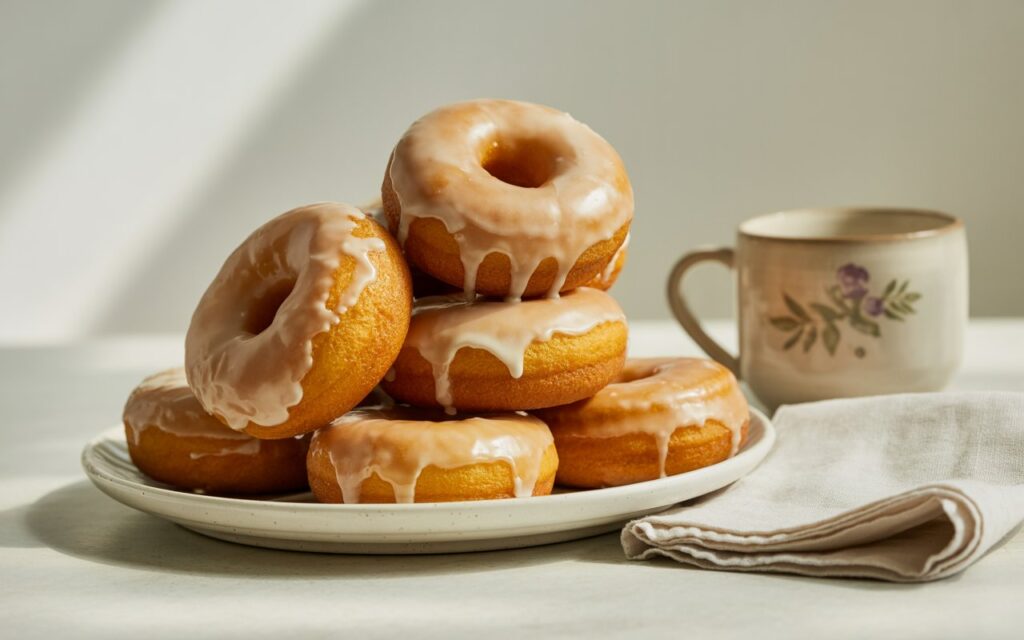
Creating Your Signature Style
Developing your personal donut style involves experimenting with flavor combinations that reflect your taste preferences and dietary needs. Document successful variations, noting specific measurements and cooking times that work with your particular air fryer model.
Consider seasonal ingredients available in your area – fresh berry purees in summer, apple cider reductions in fall, or citrus zests in winter. Local honey or maple syrup can replace some granulated sugar for unique regional flavors.
Developing Flavor Profiles
Creating memorable donut flavors requires understanding how different ingredients interact. Spices like cardamom, ginger, and chai blends transform basic donuts into exotic treats. Extract combinations – vanilla with almond, or coconut with lime – create complex flavor layers without additional wet ingredients that might affect texture.
Fruit incorporation requires special attention to moisture content. Fresh fruits add water that can make donuts soggy, while dried fruits provide concentrated flavor. Purees work best when reduced slightly to concentrate flavors and remove excess moisture.
Professional-Level Techniques
Temperature control extends beyond the air fryer settings. Room temperature ingredients blend more easily, creating smoother batters. Cold ingredients can cause butter to solidify in chunks, creating uneven texture. Conversely, ingredients that are too warm can begin cooking the eggs or melting butter prematurely.
Timing becomes crucial when working with chemical leaveners. Unlike yeast, which works slowly over time, baking powder begins reacting immediately when moistened. This reaction continues and intensifies with heat, but peaks relatively quickly. Working efficiently from mixing to air frying ensures maximum lift and the lightest possible texture.
Understanding Your Air Fryer’s Personality
Each air fryer model behaves differently due to variations in fan strength, heating element placement, and basket design. Compact models often run hotter than larger units, requiring temperature adjustments. Models with bottom heating elements may brown bottoms more quickly than tops.
Learning these quirks transforms frustration into advantage. If your air fryer browns bottoms too quickly, place a small piece of parchment under the donut pan. If tops don’t brown adequately, brush with a light egg wash before cooking.
Scaling Recipes Successfully
Doubling recipes requires more consideration than simply multiplying ingredients. Mixing larger batches can lead to overmixing if using the same technique. Mix dry ingredients thoroughly before combining with wet ingredients to ensure even distribution of leavening agents throughout the larger quantity.
Consider your air fryer’s capacity when planning larger batches. Cooking multiple small batches often produces better results than trying to crowd too many donuts into one cooking cycle. Proper air circulation is essential for even cooking and optimal texture.
Advanced Decoration and Presentation
Creating Professional-Looking Glazes
Glaze consistency dramatically affects both appearance and eating experience. Thick glazes create attractive drips but can overpower delicate donut flavors. Thin glazes soak in quickly but may not provide enough sweetness or visual impact.
The ideal glaze coats a spoon lightly and drips in a steady stream when lifted. Too thick means adding liquid one teaspoon at a time; too thin requires additional powdered sugar. Temperature matters too – slightly warm glazes spread more evenly than cold ones.
Decorative Techniques
Creating bakery-style presentations requires attention to timing and technique. Apply glazes while donuts are still slightly warm for better adhesion, but not hot enough to melt the glaze completely. This creates that perfect partially-absorbed, partially-coating effect seen in professional bakeries.
For multiple layers – such as glaze plus sprinkles plus drizzle – work quickly while each layer remains tacky. First glaze, then sprinkles, then contrasting drizzle creates depth and visual interest. Allow each layer to set briefly but not completely before adding the next.
Color and Visual Appeal
Natural colorings create appealing variations without artificial additives. Beet powder creates pink hues, turmeric adds golden yellow, and matcha powder provides vibrant green. These natural options often contribute subtle flavor notes that complement rather than compete with the base donut flavor.
Contrast creates visual drama. Dark chocolate glazes on light donuts, white glazes on chocolate donuts, or colorful sprinkles on neutral bases all create eye-catching presentations that photograph beautifully for social media sharing.
Nutritional Considerations and Healthier Alternatives
Reducing Sugar Content
Successfully reducing sugar requires understanding its multiple roles in baking. Beyond sweetness, sugar contributes to browning, moisture retention, and texture. Reducing sugar by more than 25% typically requires compensating adjustments.
Natural sweeteners like applesauce or mashed banana can replace some sugar while adding moisture and fiber. However, these substitutions change texture and may require reducing other liquid ingredients. Start with small substitutions and adjust based on results.
Increasing Nutritional Value
Whole wheat flour can replace up to half the all-purpose flour without dramatically affecting texture. Start with 25% substitution and increase gradually as taste preferences allow. White whole wheat flour provides nutritional benefits with less flavor impact than traditional whole wheat.
Adding protein powder requires careful balancing since it absorbs moisture differently than flour. Replace no more than 1/4 cup flour with protein powder, and be prepared to add additional liquid if the batter appears too thick.
Accommodating Dietary Restrictions
Egg-free versions work well using commercial egg replacers or simple substitutions like ground flaxseed mixed with water. Each creates slightly different textures, so experimentation helps determine preferred results.
Gluten-free adaptations require understanding how different flour blends behave. Some absorb more liquid, while others create denser textures. Adding xanthan gum (if not already in the blend) helps replicate gluten’s binding properties.
Building Confidence in Air Fryer Baking
Success with air fryer donuts builds confidence for tackling other baked goods in this versatile appliance. The circulating air method works excellently for cookies, small cakes, and pastries, often reducing traditional baking times significantly.
Understanding how your specific air fryer behaves – its hot spots, optimal temperatures, and timing quirks – makes you a more successful air fryer baker overall. Each model has personality quirks that become advantages once recognized and accommodated.
Conclusion
Creating delicious donuts without yeast in an air fryer represents the perfect marriage of convenience and indulgence. The technique eliminates traditional barriers to homemade donuts – long preparation times, messy oil, and complicated processes – while delivering results that satisfy both texture and flavor expectations.
The journey from mixing simple pantry ingredients to enjoying warm, golden donuts in under 30 minutes transforms how we think about homemade treats. These donuts prove that sometimes the simplest approaches yield the most satisfying results, turning everyday moments into special occasions with minimal effort and maximum reward.
Whether creating a weekend family tradition, satisfying sudden dessert cravings, or impressing guests with fresh-made treats, mastering this technique adds a valuable skill to any home baker’s repertoire. The confidence gained from consistent success encourages further experimentation and creativity in the kitchen.
Frequently Asked Questions
Q: Can I make these donuts without a donut pan?
A: Yes, you can shape the dough by hand into donut shapes and place them on parchment paper in the air fryer basket. They won’t be as uniform, but they’ll taste just as good. Alternatively, make “donut holes” in mini muffin cups.
Q: How do I know when the donuts are fully cooked?
A: Properly cooked donuts will spring back when lightly touched and appear golden brown. A toothpick inserted into the thickest part should come out clean or with just a few moist crumbs. Internal temperature should reach 190-200°F if using a thermometer.
Q: Why are my donuts dense instead of fluffy?
A: Dense donuts typically result from overmixing the batter, using expired baking powder, or packing too much flour into the measuring cup. Mix just until ingredients combine, check that your baking powder fizzes in hot water, and fluff flour before measuring.
Q: Can I double this recipe for larger batches?
A: Yes, you can double all ingredients proportionally. However, you’ll need to cook in multiple batches since most air fryers accommodate only one donut pan at a time. Prepare the batter and cook immediately for best leavening results.
Q: How long do these donuts stay fresh?
A: Air fryer donuts taste best within 24 hours of making. Store in an airtight container at room temperature for up to 3 days, or freeze unglazed donuts for up to 3 months. Refresh day-old donuts by warming in the air fryer for 1-2 minutes at 300°F.
Last update on 2025-11-28 / Affiliate links / Images from Amazon Product Advertising API
*We may earn a commission for purchases made using our links. Please see our disclosure to learn more.




